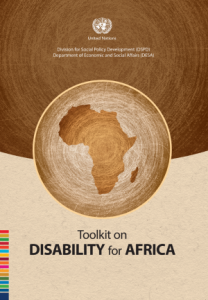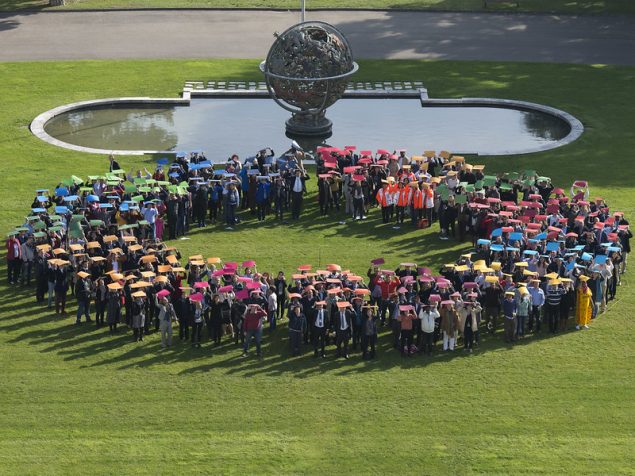Chapter Three: Monitoring the Convention and the Optional Protocol
- Main page: Handbook for Parliamentarians
- Monitoring mechanism in the Convention
- The Committee on the Rights of Persons with Disabilities
- The Optional Protocol to the Convention
- The United Nations secretariat that supports the Convention
THE COMMITTEE ON THE RIGHTS OF PERSONS WITH DISABILITIES
The Convention mandates the creation of a Committee on the Rights of Persons with Disabilities when the Convention comes into force. The Committee will examine the periodic reports submitted by States, consider individual communications, conduct inquiries, and formulate general observations and recommendations.
The Committee will initially be composed of 12 independent experts, although that number will rise to 18 after 60 States have ratified the Convention. A Conference of States parties will select the Committee members, who will serve in their personal capacity. Committee members will be chosen on the basis of their competence and experience in the field of human rights and disability, and also in consideration of equitable geographic representation, representation of different forms of civilization and legal systems, gender balance, and participation of experts with disabilities within the Committee.
States should consult with and involve persons with disabilities and their representative organizations when choosing individuals to nominate to the Committee.
Periodic reporting
Each State party to the Convention must submit to the Committee an initial comprehensive report on measures taken to implement the Convention. Each State must submit its initial report within two years after the Convention enters into force for that State. The initial report should:
- Establish the constitutional, legal and administrative framework for the implementation of the Convention;
- Explain the policies and programmes adopted to implement each of the Convention’s provisions; and
- Identify any progress made in the realization of the rights of persons with disabilities as a result of the ratification and implementation of the Convention.
Each State party must submit subsequent reports at least every four years or whenever the Committee requests one. Subsequent reports should:
- Respond to the concerns and other issues highlighted by the Committee in its concluding observations in previous reports;
- Indicate progress made in the realization of the rights of persons with disabilities over the reporting period; and
- Highlight any obstacles that the Government and other actors might have faced in implementing the Convention over the reporting period.
The Committee will set guidelines on the content of reports. The first report must be comprehensive, in other words, it must cover the implementation of all the provisions of the Convention. Subsequent reports need not repeat information previously provided. States parties should prepare their reports in an open and transparent manner and should consult with and involve persons with disabilities and their representative organizations.
The preparation of periodic reports:
- Encourages Governments to undertake a comprehensive review of national legislation, policies and programmes on human rights and disability;
- Ensures that each State regularly monitors the realization of the rights of persons with disabilities;
- Encourages Governments to set priorities and indicators against which they can judge performance;
- Provides Governments with a benchmark against which subsequent reports may be compared;
- Provides an opportunity for public discussion and scrutiny of the Government’s performance; and
- Highlights difficulties in implementation that might otherwise have gone unnoticed.
The purpose of periodic reporting
Periodic reporting provides a way of promoting States’ compliance with their obligations under the Convention, and a means of allowing the Government, national human rights institutions and civil society to appraise the level of respect for the human rights of persons with disabilities in the country. Periodic reporting before the Committee:
- Provides an instrument through which Governments, national human rights institutions and civil society can better understand the objectives and rights included in the Convention;
- Raises awareness about the Convention and the situation of the rights of persons with disabilities in the country;
- Allows the Government to benefit from the expertise of an independent, international committee on how to improve implementation of the Convention;
- Highlights good practices and experiences in the country;
- Allows Governments to benefit from the good practices and experiences of other Governments, as all periodic reports and concluding observations by the committees are public documents;
- Provides authoritative guidance to Governments, national human rights institutions and civil society for future action, including legislation, policies and programmes; and
- Indicates areas where international cooperation, particularly through the United Nations, might be desirable.
Follow-up to periodic reporting
Once the Committee has considered the report and formulated its concluding observations and recommendations, the Committee may transmit its findings to the various specialized agencies, funds and programmes of the United Nations for follow-up in the form of technical cooperation. There are many United Nations agencies whose mandates include activities relevant to the rights of persons with disabilities, such as UNESCO, ILO, WHO, the United Nations Development Programme (UNDP) and the United Nations Children’s Fund (UNICEF), as well as the World Bank. By engaging these and other organizations, States and the Committee can help ensure that periodic reporting leads to sustained improvement in the realization of the rights of persons with disabilities.
The Conference of States parties
States that have ratified the Convention will meet regularly in a Conference of States parties to consider any matter relating to the implementation of the Convention. The first meeting of the Conference of States parties will take place six months after the Convention enters into force. The Convention does not elaborate on the modalities or functions of the Conference.
Other mechanisms to monitor the rights of persons with disabilities
All human rights treaties protect the rights of persons with disabilities, which means that the independent committees of experts established under other United Nations human rights treaties also have a role in monitoring the rights of persons with disabilities within the scope of each specific treaty. For example, the Human Rights Committee has authority to monitor the civil and political rights of persons with disabilities among States parties to the International Covenant on Civil and Political Rights. The Committee on the Rights of the Child has the authority to monitor the realization of the rights of children with disabilities.
PARLIAMENTARY OVERSIGHT OF REPORTING:
THE SOUTH AFRICAN EXPERIENCE
The Committee and reporting mechanisms envisioned for the Convention are similar to those of the Convention on the Elimination of All Forms of Discrimination against Women (CEDAW). Parliaments have various ways of overseeing these reports. In South Africa, for example, all national reports to the CEDAW Committee (indeed, reports to all international monitoring bodies) have to be debated in Parliament, and Parliament must ensure that the reports contain a wide variety of views, including those of civil society. Parliament thus holds debates and public hearings, calls in ministers and requests documents and reports from a wide range of departments and citizens’ groups. In South Africa, Members of Parliament are included in the national delegations that participate in the proceedings of the CEDAW Committee, thus ensuring that they have a good understanding of the subsequent recommendations. Parliament also plays a leading role in making sure that those recommendations are put into effect at the national level.1
Footnote
1. Quoted from Parliament and Democracy in the Twenty-first Century: A Guide to Good Practice (Geneva, Inter-Parliamentary Union, 2006).
THE COMMITTEE ON THE RIGHTS OF THE CHILD
AND THE RIGHTS OF CHILDREN WITH DISABILITIES
The Committee on the Rights of the Child has been the most active United Nations human rights treaty body in the area of human rights and disability. It systematically requests information from States on the realization of the rights of children with disabilities in their countries. In September 2006, the Committee on the Rights of the Child stated that children with disabilities are still experiencing serious difficulties in fully enjoying the rights enumerated in the Convention on the Rights of the Child. The Committee emphasized that the obstacle to full enjoyment is not the disability itself, but a combination of social, cultural, attitudinal and physical barriers that children with disabilities face every day. The Committee has given guidance to States by promoting birth registration and access to information on the family environment and alternative care, basic health and welfare, education and leisure, juvenile justice, and the prevention of exploitation and abuse.
CHECKLIST FOR PARLIAMENTARIANS
How I can help ensure that periodic reporting is effective
Parliamentarians have an important role in ensuring that the Government complies with its reporting responsibilities under the Convention. Parliamentarians can:
- Ensure that the Government prepares its initial and subsequent reports on time.
- Insist that reports be drafted with the full involvement of persons with disabilities through hearings and other such consultation mechanisms.
- Request explanations from the Government when the report is late and, if necessary, use parliamentary procedures to urge the Government to comply with its reporting obligations.
- Be actively involved in the preparation of the report, such as by being a member of the relevant parliamentary committees.
- Ensure that the report includes any measures taken by parliament in favour of the rights of persons with disabilities.
- Insist on widely disseminating the Committee’s concluding observations.
- Encourage the relevant ministries to implement the Committee’s concluding observations.
- Pose questions to relevant ministers in parliament to follow up on significant obstacles to implementation.
- Publicize the issues raised in the Committee’s concluding observations through parliamentary and public debates.
Next – Chapter Three: The Optional Protocol to the Convention




